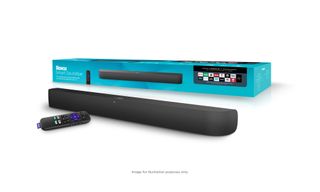Roku Is Pumping Up the Volume
One of the pain points of the modern flat-panel LED TV set is the audio. Picture quality for these newer model sets, which most often support 4K and High Dynamic Range, is better than ever. In a viciously competitive consumer-electronics market, though, it’s the picture that gets the investment.
And it’s not like there’s a lot of room for speakers within these thin devices anyway.

Thus, the sound bar and its associated subwoofer have become essential accessories for the owners of newer TV sets. Credit Roku, which seeks to maintain its leadership as the No. 1 global supplier of smart-TV user-interface software by making an, er, intelligent play in introducing its new Roku Smart Soundbar.
Retailing for $179 and available through Best Buy and Roku’s own e-commerce channel starting in October, the new device is a 32-inch Dolby Audio-equipped sound bar with HDMI ARC, Optical Audio, USB 2.0 and Bluetooth connectivity.
For another $179, you can turn up the bass with the Roku Smart Subwoofer, which contains a 10-inch driver and a digital amplifier with 250 watts of peak power.
“We’ve benchmarked this against other sound bars that are more expensive, and we’ve gone out and talked to consumers to really understand what the pain points are,” Mark Ely, vice president of whole-home product management for Roku, said.
Not Just a Hardware Play
Multichannel Newsletter
The smarter way to stay on top of the multichannel video marketplace. Sign up below.
Roku’s new sound bar embeds its most premium over-the-top player device, the 4K-capable Roku Ultra, right into the hardware. That means that if you own, say, a Samsung smart TV, you can use your new Roku sound bar to bypass the TV set’s native Samsung operating environment and use Roku’s OTT platform instead.
For Roku, it’s just another way to extend its control of the global OTT market. During its second-quarter earnings call, Roku said it had reached 30.5 million active user accounts as of the end of June. Research company Convivia reported last month that Roku’s operating environment powers 43% of the world’s connected TV devices — everything from smart TVs to HDMI dongles to the little boxes that sit on top of smart TVs.
Amazon Fire TV, which has the next biggest market share, controls only around 18% of connected TV devices, Convivia said.
For Roku, selling a bunch of $179 sound bars and subwoofers would be nice. But it’s really about the proliferation of the Roku ecosystem.
Roku generated $250.1 million in revenue in the second quarter, a 59% year-over-year uptick. The majority of that revenue, $167.1 million, was generated from “platform revenue”— that is, selling advertising on apps that exist in the Roku ecosystem, such as ad-supported VOD service The Roku Channel.
Roku’s fast-growing platform business is up 86% on a year-over-year basis in Q2. The hardware business isn’t too shabby, either, growing at 24% to $82.4 million. But Roklu’s business is increasingly about its operating system and selling ads within it. Hardware is also a means for Roku to expand its global reach.
Like Netflix, Starting in Brazil
Roku has a small presence in the U.K. and France, but the company’s real international effort is currently percolating. It plans a major Latin American push that will start out in Brazil, the same country where Netflix began its global advance in 2011.
Netflix is a company that only makes content apps that fit into ecosystems such as Roku’s. Roku makes the ecosystem, the apps that fill it up (like Roku Channel) and the hardware that enables it (like the sound bar). Unlike Netflix, though, Roku doesn’t make original content.
Still, Netflix is the OTT company that Roku is compared to most often these days.
On Nov. 1, 2011, Netflix stock bottomed out at $9.22 a share. Less than two months earlier, the subscription streaming company began its international expansion to 43 countries and territories in Central and South America, as well as the Caribbean. Brazil was Netflix’s first launch in Latin America on Sept. 5, 2011. As of midday trading on Sept. 3, Netflix shares were valued at $289.47.
Roku, which traded below $30 a share last year, was closing in on a stock price of $160 at press time.
“In our view, Roku will experience similar phased stages of international growth as Netflix did during its international expansion,” Ralph Schackart, internet and digital media analyst at Chicago-based investment bank William Blair & Co., said in a note to clients late last month.
Daniel Frankel is the managing editor of Next TV, an internet publishing vertical focused on the business of video streaming. A Los Angeles-based writer and editor who has covered the media and technology industries for more than two decades, Daniel has worked on staff for publications including E! Online, Electronic Media, Mediaweek, Variety, paidContent and GigaOm. You can start living a healthier life with greater wealth and prosperity by following Daniel on Twitter today!

